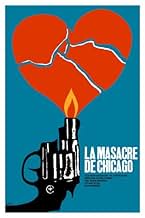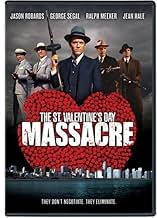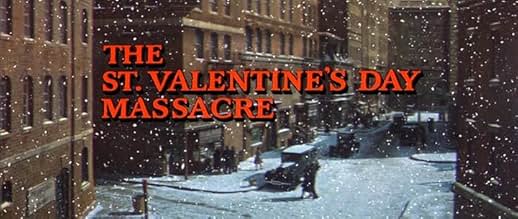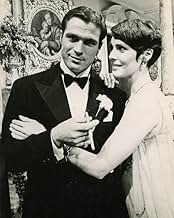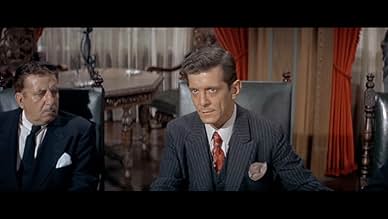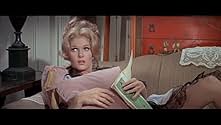IMDb-BEWERTUNG
6,6/10
5023
IHRE BEWERTUNG
Al Capone's Valentinstag-Überraschung für die rivalisierende Bugs Moran-Bande 1929 in Chicago.Al Capone's Valentinstag-Überraschung für die rivalisierende Bugs Moran-Bande 1929 in Chicago.Al Capone's Valentinstag-Überraschung für die rivalisierende Bugs Moran-Bande 1929 in Chicago.
Joe Turkel
- Jake 'Greasy Thumb' Guzik
- (as Joseph Turkel)
Empfohlene Bewertungen
8qrt7
Taking a step back from the intellectual surmising involving Godfather, Goodfellas et al., I thought this was an enjoyable film, 'a live action cartoon' as it was put.
Yep, sure it was a tad formulaic with characters going about their predetermined business and the armchair historians knew the conclusion of the film before it happened. I accept this as valid criticism, but I would stress more that it is supposed to be a quasi-documentary, with the solemn narrator venting sparse mechanical facts about each character and their relevance to the bigger picture as they were introduced. The film itself wasn't trying (I felt) to make a big artistic or intellectual statement, just an enjoyable and disposable piece of cinema. I think that it would be worse if it had been trying top make a 'big point' but fell on its arse, which a number of mobster-related films are guilty of.
As an enjoyable 'get on and enjoy the ride' movie I think it succeeded very well. Having only a basic knowledge of prohibition gangsterland, I found it quite gripping and that the documentary style enhance my enjoyment of an otherwise complex background. The set was also very well done, though Capone was miscast.
I would recommend this to most, unless they are Godfather fans!
8/10
Yep, sure it was a tad formulaic with characters going about their predetermined business and the armchair historians knew the conclusion of the film before it happened. I accept this as valid criticism, but I would stress more that it is supposed to be a quasi-documentary, with the solemn narrator venting sparse mechanical facts about each character and their relevance to the bigger picture as they were introduced. The film itself wasn't trying (I felt) to make a big artistic or intellectual statement, just an enjoyable and disposable piece of cinema. I think that it would be worse if it had been trying top make a 'big point' but fell on its arse, which a number of mobster-related films are guilty of.
As an enjoyable 'get on and enjoy the ride' movie I think it succeeded very well. Having only a basic knowledge of prohibition gangsterland, I found it quite gripping and that the documentary style enhance my enjoyment of an otherwise complex background. The set was also very well done, though Capone was miscast.
I would recommend this to most, unless they are Godfather fans!
8/10
If you love movies, this Roger Corman entry into the gangster genre is a revelation. The story is told in a series of loosely connected episodes that supposedly document real circumstances leading up to the St. Valentine's Day Massacre. A narrator tells us what we need to know for each scene, moving the action forward with an astonishing speed and clarity. Corman stamps the Docudrama style with this convention, and it really works; the immediate story is constantly informed by the narrator's voice-of-god telling of characters' past, present, and future circumstances. Even though the visual dimension of the film never escapes its studio locations, Corman's staging and his work with the actors gives it a sense of urgency. Corman has never really been talked about as an actor's director, but here he apparently had the time, the script, and I assume the inclination to let the players rip through the ceiling. The performances are all terrific. Jason Robards (looking nothing like Al Capone!) has an insane, maniacal smile that is often more unsettling than his violent rages. The camera seems to follow him around without the interruption of a cut; his mood swings keep his men in line and the viewer disarmed. True, Robards carries on, but it seems appropriate for the movie. George Segal has two great scenes that seem to play out without interruption. The one with Barbara Hale is a doozy. In fact, all through the film, Corman showcases characters in often ironic situations creating a tapestry of collective behavior that gives the film an amazing sense of vitality. Its the odd, subjective character detail that builds this story; we get involved not in the melodramatics of the story, per se, but rather in the lives of those individuals that come together who create the story.
In a very real way, Corman's approach pre-figures and creates the template for Coppola's internal view of the Mafia in the GODFATHER movies. It lacks the scope of Coppola's saga, for sure. But it sets the precedent. Corman was a terrific director. This movie was the only one he did for a major studio, 20th Century Fox. As a director, a major studio suited Corman, the artist. But as a producer, Corman has written about his distain for studio waste and book keeping. So for the next few years, before giving up directing altogether, Corman continued to work on his own under his safe and financially responsible American International umbrella. If you love movies, this is one you will cherish. Please give it a look. It a rich, satisfying, and disarmingly complex little gangster movie; terrifically entertaining.
In a very real way, Corman's approach pre-figures and creates the template for Coppola's internal view of the Mafia in the GODFATHER movies. It lacks the scope of Coppola's saga, for sure. But it sets the precedent. Corman was a terrific director. This movie was the only one he did for a major studio, 20th Century Fox. As a director, a major studio suited Corman, the artist. But as a producer, Corman has written about his distain for studio waste and book keeping. So for the next few years, before giving up directing altogether, Corman continued to work on his own under his safe and financially responsible American International umbrella. If you love movies, this is one you will cherish. Please give it a look. It a rich, satisfying, and disarmingly complex little gangster movie; terrifically entertaining.
Just one more movie that highlights how much better movies were 30+ years ago than they are now. If this story were told today, the gore would overwhelm most of the plot and all of the entertainment.
As is, even the shlock Roger Corman produces a highly enjoyable, rapid paced vehicle. The scene with George Segal and Jean Hale is reminiscent of the one between Glenn Ford and Hope Lange in "Pocketful of Miracles." And, after watching it, one wonders why Jean Hale's filmography is so short.
Only Jason Robards, Jr. really overdoes it, but who's to say that Capone himself didn't overact a bit? Certainly no one who's alive to write a review here.
More entertaining than many other 60's gangster flicks, including "Bonnie and Clyde," "Dillinger," and the depressing "Murder, Inc."
While "The Godfather" series and "Goodfellas" were much higher budget and quality productions, both had parts which were overextended or just downright dull (for example, the long drawn out day of Henry Hill's arrest in "Goodfellas").
This one doesn't. It rocks from beginning to end. And most of the cast (such as the ubiquitous Charlie Dierkop) look more like hoodlums than real hoodlums do. (I think.)
Very high marks for sheer entertainment value.
As is, even the shlock Roger Corman produces a highly enjoyable, rapid paced vehicle. The scene with George Segal and Jean Hale is reminiscent of the one between Glenn Ford and Hope Lange in "Pocketful of Miracles." And, after watching it, one wonders why Jean Hale's filmography is so short.
Only Jason Robards, Jr. really overdoes it, but who's to say that Capone himself didn't overact a bit? Certainly no one who's alive to write a review here.
More entertaining than many other 60's gangster flicks, including "Bonnie and Clyde," "Dillinger," and the depressing "Murder, Inc."
While "The Godfather" series and "Goodfellas" were much higher budget and quality productions, both had parts which were overextended or just downright dull (for example, the long drawn out day of Henry Hill's arrest in "Goodfellas").
This one doesn't. It rocks from beginning to end. And most of the cast (such as the ubiquitous Charlie Dierkop) look more like hoodlums than real hoodlums do. (I think.)
Very high marks for sheer entertainment value.
It's incredible to think that this film, Roger Corman's major studio debut, and THE GODFATHER (made by Corman alumnus Coppola) were made within five years of each other. They could be decades apart, in look, in sensibility, in impact. Whereas GODFATHER gropes for a rich, mythic timelessness, MASSACRE seems brittle, thin, a mere pastiche of, variously, 30s Warners gangster films, 40s B-movies, or Corman's own early work. Whereas Coppola's characters have passed into popular culture, Corman's gangsters are thinly characterised, theatrical, parodic; whereas GODFATHER's plot is slow-burning, tense, silent, punctuated with shocking shards of tangible violence, MASSACRE is almost cartoon-like in its relentless gunfire, which, because it's not rooted in character, does not have as traumatic an effect.
Some of us, however, might recoil a little from the major film's more questionable posturing, and MASSACRE has many excellencies. Most immediately pleasurable is the plot, mathematically simple, as Corman narrates the titular bloodbath like a theorem, showing A (Capone) meeting B (Moran) to create C (the massacre). QED. Nothing is allowed interfere with this beautiful simplicity - every scene, every character, every action refers to this theorem alone. Even scenes which seem to illustrate character (eg Peter Gusenberg and Myrtle) only do so to 'explain' why one side got the better of another.
This quality extends to the film as a whole, which is a series of repetitions and mirroring scenes. Another pleasure is the voiceover, which again transforms a conventional narrative about real people into abstract formalism. Like a voice of God, it intrudes without warning, frequently, mixing bald factual details about all the players (eg Such and such, born 1893 in such a place, suspected gun-runner, killer etc., will die on 3 May 1957 of heart failure) with speculation. Before any character has even begun their parts in the film, their life stories are known to us. This robs them of everything that makes us human - motivation, hope, action. Sartre said we are what we do. Not here. Robbed of human characteristics, they become mere ciphers, playing out their inevitable fates, and denying the viewer the kind of emotional empathy that Coppola will dubiously over-indulge in.
Despite the (relatively) high budget, production values do nothing to make the film more realistic. Indeed, the uniformity of colour (predominantly grey), the repetition of scenes and places, the reduction of sequences to sheer functionality, makes the film increasingly artificial. The theatricality of the acting adds to this, with Robards especially hamming away to amusingly grand effect, but theatricality is embedded too, as narratively crucial scenes become sites for rhetoric, oratory, dramatic performance, an actor declaiming to an enrapt public, hanging (for dear life) to his every word.
Add to all this Corman's stunning, playful direction, confident and fluid, making interiors and objects live, fixing characters in their place. The violent scenes are expertly choreographed, if they aren't disturbing, their formal excellence is undiminished. All this formalism is not an empty, academic exercise. By revealing the phoniness of his subject matter, Corman reveals the processes of myth-making that, especially through the cinema, curiously glamourised an era, when America was in thrall to a number of violent fascists.
Corman is not seriously moralistic, he is cheerfully aware of human nature's strange pulls - he shows how the need for violence and sensation in cinema is close to the fascistic, but also undeniable. It is a trap Coppola doesn't always avoid. The score, which makes ragtime eerily modernist, is astounding, while Corman reveals, as in TALES OF TERROR, that he has a canny sense of the domestic's comic violence - the Pete/Myrtle scene is a hilarious-troubling classic.
Some of us, however, might recoil a little from the major film's more questionable posturing, and MASSACRE has many excellencies. Most immediately pleasurable is the plot, mathematically simple, as Corman narrates the titular bloodbath like a theorem, showing A (Capone) meeting B (Moran) to create C (the massacre). QED. Nothing is allowed interfere with this beautiful simplicity - every scene, every character, every action refers to this theorem alone. Even scenes which seem to illustrate character (eg Peter Gusenberg and Myrtle) only do so to 'explain' why one side got the better of another.
This quality extends to the film as a whole, which is a series of repetitions and mirroring scenes. Another pleasure is the voiceover, which again transforms a conventional narrative about real people into abstract formalism. Like a voice of God, it intrudes without warning, frequently, mixing bald factual details about all the players (eg Such and such, born 1893 in such a place, suspected gun-runner, killer etc., will die on 3 May 1957 of heart failure) with speculation. Before any character has even begun their parts in the film, their life stories are known to us. This robs them of everything that makes us human - motivation, hope, action. Sartre said we are what we do. Not here. Robbed of human characteristics, they become mere ciphers, playing out their inevitable fates, and denying the viewer the kind of emotional empathy that Coppola will dubiously over-indulge in.
Despite the (relatively) high budget, production values do nothing to make the film more realistic. Indeed, the uniformity of colour (predominantly grey), the repetition of scenes and places, the reduction of sequences to sheer functionality, makes the film increasingly artificial. The theatricality of the acting adds to this, with Robards especially hamming away to amusingly grand effect, but theatricality is embedded too, as narratively crucial scenes become sites for rhetoric, oratory, dramatic performance, an actor declaiming to an enrapt public, hanging (for dear life) to his every word.
Add to all this Corman's stunning, playful direction, confident and fluid, making interiors and objects live, fixing characters in their place. The violent scenes are expertly choreographed, if they aren't disturbing, their formal excellence is undiminished. All this formalism is not an empty, academic exercise. By revealing the phoniness of his subject matter, Corman reveals the processes of myth-making that, especially through the cinema, curiously glamourised an era, when America was in thrall to a number of violent fascists.
Corman is not seriously moralistic, he is cheerfully aware of human nature's strange pulls - he shows how the need for violence and sensation in cinema is close to the fascistic, but also undeniable. It is a trap Coppola doesn't always avoid. The score, which makes ragtime eerily modernist, is astounding, while Corman reveals, as in TALES OF TERROR, that he has a canny sense of the domestic's comic violence - the Pete/Myrtle scene is a hilarious-troubling classic.
Chicago, Prohibition, Gangsters, Machine Guns and Hollywood have long been inseparable companions ever since the real Prohibition Era was loosed upon us. Starting with James Cagney in THE PUBLIC ENEMY(1931), LITTLE CEASAR(1931) and SCARFACE(1932) are each powerful films that fit these qualifications like a proverbial glove. Each meets the individual criterion and tell their stories in somewhat different ways of story telling.They each use the point of view of the title characters.
And so that's the way it was, back in the day! And of course there have been revivals of this particular topic and Genre every so often. Hence we have been treated to The Prohibition/Depression Era Gangster films like ROGER TOUHY,GANSTER(1944)*, AL CAPONE and THE PURPLE GANG(both 1959), THE GODFATHER(s), I,II & III(1972,'73, '90) and soon and so forth, down thru the ages.
And of course on TV we had THE LAWLESS YEARS(1959-61) and of course, last but hardly the least,THE UNTOUCHABLES(1959-63)to give further lore to the celluloid underworld. It is probably likely that we'll always have some of these Gangster Soap Operas every so often.
As for this ST. VALENTINE'S DAY MASSACRE, we must say we saw it at the old Double Drive-In on the Southwest Highway in Chicago when it was in newly released/first run status. We saw it again, recently on cable TV, on Turner Classic Films or Fox Movie Channel. It might sound peculiar, but did you ever hear of a movie getting better? Let me explain.
The original viewing was done by a 20 year old, still wet behind the ears kid, who just viewed any movie as another entertainment to be viewed, (devoured-up, if you will) and forgotten. There was really no sense of a "Medium" or being "An Art Form". With age of course, is supposed to come wisdom, or at least a little experience under one's belt.
After a period of nearly 40 years has passed, this writer has found himself to be not a'movie fan',but rather a 'film buff'. The big difference is in the viewing over the years and,more importantly,all of the reading of film books and periodicals containing the history and background information.
As for the title in question, THE ST. VALENTINE's DAY MASSACRE, well I can't say that it was every bit as good when viewed now as it was then. No, because it is even better! The movie was Produced and Directed by Mr. Roger Corman. Now the brain (mine, for what it's worth) takes one name of The Director/Producer and adds it to the venue of a Drive-In Movie Theatre and it computes to a cheapie, a grade "B" film at best. And to be honest, until just recently, I had thought that this movie was a product of the ever popular, Amerkican-Interntional Pictures. After all, that's where Roger Corman used to hang his hat.
This 20th Century-Fox production is really a well done movie, deserving of a new respect and frequent showings.** The costuming, the autos and the sets are all very good and approximate the real locales in Chicago and nearby suburban Cicero, Illinois. The mock up of the famous and infamous Garage on North Wells Street has a very authentic look to it. Even the type of apartment building used by the conspirators is a Chicago-type building, of which there are still thousands of the yet in use there today.
Mr. Corman pursues a form of the Docudrama to a large degree, in unveiling the story. The voice over narration gives us, the viewers the benefit of all that has been learned since then. Also, we have the information of the official Police Investigation now available for the Public Record.In this we have many conclusions that have been made, but not proved, sort of educated guesses.
The story starts out giving the viewer a great deal of background info about the state of Chicago's Underworld at that time in the late 1920's We are privy to the old Northside, Southside, Westside rivalries that the various Gangs were involved in. The previously mentioned Narrator, Voice Actor Par Excellance, Paul Frees, is very busy from beginning to end in supplying us with factual material about the criminal careers of the peoples involved.
As a historical fact we observe the Gangland Killings of Northside Big Shot Hoods Dion O'Bannion(Chicasgo Native John Agar)and Hymie Weiss (Reed Hadley) and the continued battling over territories. Mr.Corman also includes a seemingly fantastic, but factual raid by the Northside Mob on Capone Gang Headquarters. A really large number of autos, replete with multiple Thompson Sub-Machine Guns attacked the favourite watering hole of the Scarface Mob. They failed to kill Capone or anyone of the gang, in spite of perhaps thousands of rounds of that super fast .45 caliber disbursement at the intended target.
Like any Hollywood treatment of a story taken from real life occurrences, there is a lot of filling in gaps and causes of these incidents. The unknown aspects of the people involved and their behaviour is also subject to guess work, albeit an enlightened, educated guess at that. Whatever was known about the characters in question was used as guidelines for molding on-screen persona.
One last time, please take a new look at it. On Cable/Satellite, in VHS or DVD, Purchase or Rental, make an evening with THE ST. VALENTINE's DAY MASSACRE.
* The real Roger Touhy, a Prohibition Era Gangster Headquartered in Northwest Suburban Des Plaines, Illinois sued 20th Century-Fox over this largely fabricated story. Hint To Hollywood: A realistic Roger Touhy story really would make a great film! Check on it!
** Maybe my own fair city, Chicago, is missing the boat on this one! After all, why can't we have a Yearly Massacre Fest? It could be a rival to events all around the country such as: The Kentucky Derby, Mardi Gras, Sadie Hawkins Day or even The Bull Frog Leaping Contest of Calaveras County.
And so that's the way it was, back in the day! And of course there have been revivals of this particular topic and Genre every so often. Hence we have been treated to The Prohibition/Depression Era Gangster films like ROGER TOUHY,GANSTER(1944)*, AL CAPONE and THE PURPLE GANG(both 1959), THE GODFATHER(s), I,II & III(1972,'73, '90) and soon and so forth, down thru the ages.
And of course on TV we had THE LAWLESS YEARS(1959-61) and of course, last but hardly the least,THE UNTOUCHABLES(1959-63)to give further lore to the celluloid underworld. It is probably likely that we'll always have some of these Gangster Soap Operas every so often.
As for this ST. VALENTINE'S DAY MASSACRE, we must say we saw it at the old Double Drive-In on the Southwest Highway in Chicago when it was in newly released/first run status. We saw it again, recently on cable TV, on Turner Classic Films or Fox Movie Channel. It might sound peculiar, but did you ever hear of a movie getting better? Let me explain.
The original viewing was done by a 20 year old, still wet behind the ears kid, who just viewed any movie as another entertainment to be viewed, (devoured-up, if you will) and forgotten. There was really no sense of a "Medium" or being "An Art Form". With age of course, is supposed to come wisdom, or at least a little experience under one's belt.
After a period of nearly 40 years has passed, this writer has found himself to be not a'movie fan',but rather a 'film buff'. The big difference is in the viewing over the years and,more importantly,all of the reading of film books and periodicals containing the history and background information.
As for the title in question, THE ST. VALENTINE's DAY MASSACRE, well I can't say that it was every bit as good when viewed now as it was then. No, because it is even better! The movie was Produced and Directed by Mr. Roger Corman. Now the brain (mine, for what it's worth) takes one name of The Director/Producer and adds it to the venue of a Drive-In Movie Theatre and it computes to a cheapie, a grade "B" film at best. And to be honest, until just recently, I had thought that this movie was a product of the ever popular, Amerkican-Interntional Pictures. After all, that's where Roger Corman used to hang his hat.
This 20th Century-Fox production is really a well done movie, deserving of a new respect and frequent showings.** The costuming, the autos and the sets are all very good and approximate the real locales in Chicago and nearby suburban Cicero, Illinois. The mock up of the famous and infamous Garage on North Wells Street has a very authentic look to it. Even the type of apartment building used by the conspirators is a Chicago-type building, of which there are still thousands of the yet in use there today.
Mr. Corman pursues a form of the Docudrama to a large degree, in unveiling the story. The voice over narration gives us, the viewers the benefit of all that has been learned since then. Also, we have the information of the official Police Investigation now available for the Public Record.In this we have many conclusions that have been made, but not proved, sort of educated guesses.
The story starts out giving the viewer a great deal of background info about the state of Chicago's Underworld at that time in the late 1920's We are privy to the old Northside, Southside, Westside rivalries that the various Gangs were involved in. The previously mentioned Narrator, Voice Actor Par Excellance, Paul Frees, is very busy from beginning to end in supplying us with factual material about the criminal careers of the peoples involved.
As a historical fact we observe the Gangland Killings of Northside Big Shot Hoods Dion O'Bannion(Chicasgo Native John Agar)and Hymie Weiss (Reed Hadley) and the continued battling over territories. Mr.Corman also includes a seemingly fantastic, but factual raid by the Northside Mob on Capone Gang Headquarters. A really large number of autos, replete with multiple Thompson Sub-Machine Guns attacked the favourite watering hole of the Scarface Mob. They failed to kill Capone or anyone of the gang, in spite of perhaps thousands of rounds of that super fast .45 caliber disbursement at the intended target.
Like any Hollywood treatment of a story taken from real life occurrences, there is a lot of filling in gaps and causes of these incidents. The unknown aspects of the people involved and their behaviour is also subject to guess work, albeit an enlightened, educated guess at that. Whatever was known about the characters in question was used as guidelines for molding on-screen persona.
One last time, please take a new look at it. On Cable/Satellite, in VHS or DVD, Purchase or Rental, make an evening with THE ST. VALENTINE's DAY MASSACRE.
* The real Roger Touhy, a Prohibition Era Gangster Headquartered in Northwest Suburban Des Plaines, Illinois sued 20th Century-Fox over this largely fabricated story. Hint To Hollywood: A realistic Roger Touhy story really would make a great film! Check on it!
** Maybe my own fair city, Chicago, is missing the boat on this one! After all, why can't we have a Yearly Massacre Fest? It could be a rival to events all around the country such as: The Kentucky Derby, Mardi Gras, Sadie Hawkins Day or even The Bull Frog Leaping Contest of Calaveras County.
WUSSTEST DU SCHON:
- WissenswertesFor the massacre scene in the garage, the actors playing the slain gangsters were shown photos and directed as how to fall so their positions were identical to the real photos of the massacre. Two actors bumped together on the way down. After studying photographs they realized they had fallen and collided in the exact way the slain gangsters had fallen and had landed in the correct positions.
- Zitate
Reporter: Y'know some are sayin' that it really was the cops who shot those men.
Bugs Moran: You must be new to this town, mister. Only Al Capone kills like that.
- VerbindungenEdited into Capone (1975)
Top-Auswahl
Melde dich zum Bewerten an und greife auf die Watchlist für personalisierte Empfehlungen zu.
- How long is The St. Valentine's Day Massacre?Powered by Alexa
Details
- Erscheinungsdatum
- Herkunftsland
- Sprachen
- Auch bekannt als
- La masacre de Chicago 1929
- Drehorte
- Desilu Studios - 9336 W. Washington Blvd., Culver City, Kalifornien, USA(street scenes, garage - exteriors)
- Produktionsfirma
- Weitere beteiligte Unternehmen bei IMDbPro anzeigen
Box Office
- Budget
- 1.000.000 $ (geschätzt)
- Laufzeit1 Stunde 40 Minuten
- Farbe
- Seitenverhältnis
- 2.35 : 1
Zu dieser Seite beitragen
Bearbeitung vorschlagen oder fehlenden Inhalt hinzufügen

Oberste Lücke
By what name was Chicago-Massaker (1967) officially released in India in English?
Antwort

